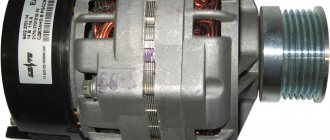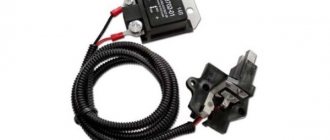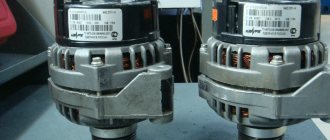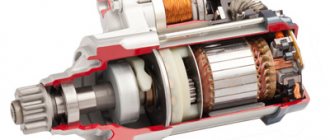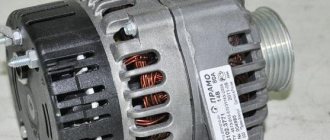Problems with voltage in the on-board network are typical for many AvtoVAZ cars. They worry owners because they damage various electrical equipment to the point of making it impossible to operate the car. Therefore, motorists are interested in the question of how much a VAZ 2114 generator should produce.
In this article we will tell you what the voltage of the generator should be and how many amperes it is designed for. We will also look at the main causes of low and high voltage, their consequences, and ways to check the generator.
How many volts and amperes should the VAZ 2114 generator produce?
The generator of the “fourteenth”, like any other car, is designed to convert the energy produced by the motor into electric current. The electricity it generates powers all the electrical equipment of the car. For normal operation, the generator must have a certain current strength and produce the required voltage.
In this regard, many owners are interested in how many amperes the VAZ 2114 generator produces. If the car has a standard part, then it is designed for 90 A. question of how many volts a generator on a VAZ 2114 should produce is no less than 13-13.2 V. On average, this value is 13.6 V. But this is at full load. When consumers are turned off, it is much higher.
Which generator should you choose?
Before we get to the story about which VAZ 2114 generator is better, it’s worth saying - why shouldn’t you buy a battery native to the 14th model? The fact is that it is designed for a fairly low current - only 80 A.
Considering that while the car is running, the generator has to not only charge the battery, but also power electronic devices, this current is simply not enough to fully charge the battery (we should also add, albeit small, current losses in the circuit). That is why it is advisable to install a more powerful generator.
When choosing a generator in a car store, it is better to give preference to more expensive models. As the practice of many drivers shows, the cheapest models of generators fail almost immediately.
So, what devices can be installed on the VAZ 2114?
Firstly, without any modifications you can install 37.3701 from the 15th model. It is completely interchangeable with the original 14th generator, but the problem is that its amperage is even less - only 55 A. Therefore, it should be installed only as a last resort.
New generator VAZ 2114
The second acceptable option is a generator from Priora or Kalina - it creates a current of 115 A, which is enough to charge the battery and operate all on-board electronics. True, you will have to replace the device pulley with a more suitable one.
The third option is a generator from PRAMO, which has an amperage of 120 A. This is the most optimal option of all for 2114.
Generator from PRAMO
And finally, generators from Eldix with a current of 80 or 115 A - they are completely identical to the 14th model generator in terms of external dimensions and pulley parameters. The only thing worth remembering is that they are practically not repairable. Even if there is a minor breakdown, the entire device will have to be replaced.
What generator is installed on the VAZ 2114?
Having figured out what voltage the generator on the VAZ 2114 should produce, it’s worth understanding what kind of device produces it. This domestic hatchback is equipped with a three-phase generator type 94.3701 . It consists of a stationary winding or stator, a rotor, rotor bearings, an impeller, and a pulley for putting on a belt. It also has a diode bridge or rectifier, a voltage regulator and a housing.
Russian-made devices of the KZATE brand were installed on the car from the factory. Also, on some cars of recent years of production you can find standard German Bosch. Despite the fact that domestic generators, with proper care, can be used for a relatively long time, foreign-made parts are considered more reliable. Therefore, when replacing, many owners buy products from this or another foreign brand. In addition, sometimes more powerful generators are installed. They are purchased, for example, by car audio enthusiasts, since the factory ones are not designed for such a heavy load.
Useful : Where is the VAZ 2114 generator fuse located?
Test of automobile generators KZATE, LKD, Fenox, "Pramo" and "StartVOLT"
Every motorist who is interested in the design of his iron horse knows that the main source of electricity in the electrical equipment of any car is a power plant, which includes a battery, a generator and a relay regulator. The battery is the main one in this trio. It powers the entire on-board network of the car, and the generator with a relay regulator, to the extent possible and necessary, feeds the battery and ensures that the on-board network of the car does not exceed the specified voltage (for cars with 12-volt equipment, this voltage is 14-14 .6 V, and for 24-volt - 27-28.8 V). And although generators in a car are long-lasting items, they sometimes fail. Let's see what the Russian market offers us to replace a failed generator, and at the same time test the proposed models in our testing laboratory.
To begin with, a small educational program. The generator is necessary for uninterrupted charging of the constantly discharged battery by electrical appliances included in the vehicle’s on-board network. Modern cars are equipped with alternating current generators. They best meet the requirements for one of the most important power components of a car.
The generator converts mechanical energy received from the engine into electrical energy. The voltage regulator (in the vast majority of modern cars is an integral part of the generator, with rare exceptions when the regulator is “remote”, that is, placed in the engine compartment, separately from the generator) maintains the voltage of the vehicle’s on-board network within specified limits when the electrical load and rotation speed change generator rotor and ambient temperature.
A car generator must provide an uninterrupted supply of current and have sufficient power to:
- supply electricity to the battery, which is constantly discharged by working on-board consumers;
- When all regular electricity consumers were turned on at low engine speeds, the battery did not discharge.
In addition, the generator must have sufficient strength, a long service life, small weight and dimensions, low noise levels and radio interference.
Summarizing all of the above, we can conclude that the generator is the heart of the car’s electrics, which must always “beat” and provide current for charging in order for the car to “live.”
Understanding the importance of this automotive unit, we turned our attention to the market of generators for domestic cars.
For a comparative test, we purchased five car generators from a regular spare parts store. These are generators of the KZATE, LKD, Fenox, Pramo and StartVOLT brands. All of them are designed for installation on VAZ car engines.
Alternating current generator 9402.3701-01 with built-in rectifier unit and analog voltage regulator (14 V; 80 A; 1.12 kW; 1200/6000 min-1; 4.9 kg) - JSC "Plant im. A. M. Tarasov" (JSC "ZiT") - KZATE brand (Russia)
This generator is considered standard, since it is the generators of this plant that are supplied to the AvtoVAZ conveyor.
The build quality did not raise any complaints. The generator is repairable.
A little about the evaluation methodology: to measure the current-voltage characteristics, the generators were installed on a specialized stand. Generators must provide the maximum current strength at crankshaft speeds from 1500 to 2500.
At 700 crankshaft revolutions per minute, this generator showed a current value of within 40 A with a predisposition to “attenuation”. When reaching the nominal speed, the KZATE generator confirmed the declared 80 A and even reached 90 A. Assessing the reviews of motorists, we can say with confidence: this generator is a variant of the classic reliable design without a claim to outstanding performance, but guaranteeing trouble-free operation.
Testing of the KZATE generator at 700 rpm of the engine crankshaft
Testing of the KZATE generator at 2000–2500 rpm of the engine crankshaft
Alternating current generator 9402.3701 P with built-in rectifier unit and analog voltage regulator (14 V; 100 A; 1.4 kW; 1200/6000 min-1; 4.85 kg) - LKD Electrical (China)
The LKD generator almost completely repeats the design of the KZATE generator described above. It is characterized by the same features in terms of workmanship and maintainability.
However, even when installed on the stand, the LKD generator showed its complete inoperability. When identifying the cause of the failure, a lack of soldering was discovered on the supply wire of the regulator relay. When considering the future fate of the generator, we decided to exclude it from the tests. Even though troubleshooting could take several minutes, we decided to take the consumer's position. Having paid money, the consumer does not have to independently eliminate the manufacturer’s defects and carry out modifications on his own.
LKD generator lack of charge
Subsequently, we took an interest in consumer reviews on the Internet for this generator and found other negative responses to this test subject, with the only difference being that someone had to pay a little more for it.
Alternator AL 21305 with built-in rectifier unit and analog voltage regulator (14 V; 80 A; 1.12 kW; 1200/5500 min-1; 5.6 kg) – Fenox Global Group (Belarus)
The Fenox brand generator is identical in design to the two described earlier. However, upon inspection of this generator, higher quality workmanship was found. Maintainability at the same level requires the intervention of a trained specialist. Knowing the “sores” of such generators, we checked the tightening of the contacts. As it turned out, it was not in vain. If they had not been tightened, the consequences would have been sad, albeit in the foreseeable future: melting of the contacts due to the formation of transient resistances during the passage of high currents, subsequent failure of the unit. In fact, this is more of a prevention than a crime. All generators were subjected to this procedure.
Bench tests of the Fenox generator showed the following results. When operating at 700 crankshaft revolutions per minute, it was possible to achieve values at the level of 45-50 A with obvious signs of “damping”. When the crankshaft speed increased to 2500, the generator produced 90 A under load, but that was all.
Fenox generator testing at 700 rpm engine crankshaft
Testing the Fenox generator at 2000-2500 rpm of the engine crankshaft
Alternating current generator 5102.3771 with built-in rectifier unit and analog voltage regulator (14 V; 100 A; 1.4 kW; 1200/5500 min-1; 5.4 kg) - JSC Concern Pramo (Russia)
The design of the Pramo brand generator is somewhat different from the previous three: a different casting is used, a different design of bearing supports is used. Securing the bearings using flanges, among other things, made it possible to significantly increase the maintainability of the unit. To repair the bearing assembly of this generator, you can attract specialists with less qualifications.
The diode bridge of the generator also differs in design. The design exactly copies the design used in Bosch generators. But the diode bridge itself is not repairable. The leads from the stator winding are sealed on a diode bridge. In general, maintainability is sacrificed for stable contact.
Bench tests of the Pramo generator showed the following results. When operating at 700 crankshaft rpm under load, a value of 50 A was achieved. When the crankshaft rpm increased to 2500, the generator reached a value of 100 A under load.
Testing the "Pramo" generator at 700 rpm of the engine crankshaft
Testing the "Pramo" generator at 2000-2500 rpm of the engine crankshaft
Alternating current generator "StartVOLT" LG 0110 with a built-in rectifier unit and digital voltage regulator (14.6 V; 120 A; 1.9 kW; 1200/5500 min-1; 5.3 kg) - Carville LLC (St. Petersburg)
In design, the StartVOLT brand generator is very close to such representatives as KZATE, LKD and Fenox. Its diode bridge is also similar to them, with the exception of the presence of two additional power diodes designed to produce additional power take-off, as the developer states. This is the so-called use of the third harmonic, which is simply not used in other generators.
The stator winding terminals do not have mechanical contacts. The stator winding leads are sealed on a diode bridge. The relay-regulator, unlike all those described above, is digital, not analog, again according to the manufacturer, and it is also assumed that, among other things, “a field-effect transistor is installed on the output switch, which has zero resistance when opening, which ensures a decrease losses."
The bearing units are also similar to the designs of the KZATE, LKD and Fenox generators.
And the most important significant difference from all previous models is the declared current of 120 A!
We did not take the manufacturer’s word for it, but bench tests of the StartVOLT generator showed the following results: when operating at 700 crankshaft rpm under load, we managed to achieve a value of 60 A. Amazingly, when the crankshaft rpm increased to 2500, the generator reached the declared value of 120 A under load! De facto, this is almost 50% more than that of a standard KZATE generator.
Testing of the StartVOLT generator at 700 rpm of the engine crankshaft
Testing of the StartVOLT generator at 2000-2500 rpm of the engine crankshaft
So, let's sum up the intermediate results. With almost identical designs, the “zest” of the StartVOLT generator made it possible to achieve 30-50% better performance than that of potential competitors. All we have to do is summarize the measurement data in a table, enter prices and expert assessments.
CONCLUSIONS
The classic model of a standard generator from KZATE is in demand among motorists, although it cannot be said that the increased need for more powerful generators is a requirement of the time. Therefore, this model, despite its quality and the level of the manufacturer itself, is morally outdated. Therefore, our choice fell on the generator as it is more interesting in terms of real characteristics.
How to measure generator voltage?
Knowing what voltage the generator should produce, you also need to be able to measure it. Otherwise, it will be impossible to understand that it is too low or prohibitively high. There are two ways to measure voltage. The first one is very simple, but imprecise. The car's on-board computer shows the voltage. Therefore, you can simply look at his testimony. Unfortunately, they are often underestimated. Therefore, you should not rely on these data to accurately diagnose the generator. In addition, sometimes the voltage on the on-board computer fluctuates under load. But this is not always a reason to troubleshoot. Perhaps one of the consumers is too powerful or connected incorrectly. Or is it just a device error.
The second method gives the most accurate result. To do this you will need a multimeter and an assistant. The measurement is performed in the following sequence:
- Turn on the ignition and make sure that all warning lights on the dashboard light up as normal;
- Start the car and check that the battery indicator goes out. If the battery icon is on, it means the generator, battery or wiring problems are faulty;
- Warm up the car to operating temperature and turn on all available electrical consumers;
- Take a multimeter and set it to voltmeter mode;
- Ask an assistant to maintain engine speed within 3500;
- The multimeter is connected to the battery;
- Evaluate the measurement result. If everything is in order, the multimeter will show approximately 13-13.2 V or a little more. If the readings are lower, the generator or battery is faulty.
Next, you should carry out the same check with the consumers turned off. With a working generator, the voltmeter will show about 14.5-14.7 V.
To diagnose the generator, you need to connect a multimeter to its terminals. The device should display values in the range of 14-14.3 V. Then you should ask an assistant to increase the engine speed. The voltage of a working generator should not jump by more than 0.5 V. If it changes or was initially lower or higher than expected, the unit needs to be repaired.
Generator - performance check
Many car enthusiasts are interested in how to test a new generator that has just been installed on a car? Or how to check that the old one has already failed, although it seems to be working normally? After all, driving with a faulty generator can have a number of unpleasant consequences, the easiest of which is completely discharging the battery and stopping the car, and the most severe is damage to the on-board network and devices.
In order to test this device, you will need a tester (multimeter).
The diagnosis itself is performed in the following order:
- Turn on the ignition.
- Check to see if the generator/battery lights on the instrument panel come on.
- Start the engine - if the light goes out, then everything is in order, if not, then there is a malfunction.
- Wait until the engine warms up to operating temperature.
- Turn on ALL electrical consumers - lights, fans...
- We bring the engine speed to 3500.
- Turn on the multimeter in voltage measurement mode and connect the probes to the battery.
- If the generator is working, the multimeter will show 13 volts, if less, then there is a malfunction.
- Without turning off the engine and maintaining speed, turn off all electricity consumers - the multimeter should now show 14.7 volts or slightly higher - this also indicates that the device is working properly.
Checking voltage with a multimeter
By performing the test according to the specified scheme, you can quickly and accurately determine whether the generator is working. But, there are a number of indirect signs that may also indicate a malfunction of this device.
These include:
- the battery charging icon is constantly lit;
- interruptions in the operation of electrical equipment, flickering headlights;
- boiling of the electrolytic solution in the battery;
- Generator operation is too noisy (as a result of bearing failure).
If you detect even one of these signs, you should immediately perform a full check (according to the scheme described above). If it turns out that the generator is faulty, a new one should be installed instead. But we’ll look at which generator is better to put on a VAZ 2114 below.
Recharging the battery
Sometimes when the generator breaks down, the battery overcharges. This can be noticed not only when taking measurements with a multimeter, but also in the readings of the on-board vehicle. And if the set voltage is greatly exceeded, various electrical equipment may fail or the battery may boil out. Also, the headlights may shine brighter than usual, and the battery charge indicator on the dashboard will constantly light up. These are the main symptoms of overcharging. It occurs most often due to a faulty voltage regulator. This part on the VAZ 2114 can be easily changed with your own hands.
And the battery and generator diagnostics described above will help determine the exact presence of the problem.
The VAZ 2114 generator may have a number of the following malfunctions
- The fuse in the mounting block has blown; to fix it, you just need to replace it;
- There has been a break in the power supply circuit of the instrument cluster; here you need to check wire “0”, as well as its connection to the instrument cluster;
- The ignition switch does not operate; in this case, the contact part of the switch should be checked and, if necessary, replaced;
- Wear, hanging of the brushes or oxidation of the contact rings, you need to replace the brush holder and the brushes themselves, and wipe the rings with a napkin moistened with gasoline;
- The voltage regulator is damaged - you need to replace the regulator itself;
- Short circuit in the positive valves - the rectifier unit should be replaced;
- The generator belt slips; here it is enough to adjust its tension;
- Broken belt - replacing the alternator belt will help;
- The generator bearing is damaged - only installing a new bearing will help.
These are a number of minor faults, but even they can sometimes lead to the need to replace the generator. In general, it is better to entrust the repair of generators to professionals from automobile workshops, but if you are well versed in cars, you can repair the generator yourself. To do this, you may need a generator diagram, which you can find on the Internet or in VAZ 2114 repair manuals. If something happens, buy a generator in a store for 2100-2300 rubles.
It is also worth noting that the 2110 generator is exactly the same as the 2114, so there is no need to be confused if you hear the designation of the first model.
The generator produces low voltage
Unlike overcharging, which is observed infrequently, owners of the “four” often encounter low voltage in the on-board network. It can be determined not only by readings on the dashboard or by measurements with a voltmeter. The most common symptoms of this problem are:
- Constantly lit battery indicator on the dashboard;
- Low voltage on the on-board computer (although it often lies a lot);
- Dim or flickering headlights and dashboard lights;
- Failure of electrical appliances or their unstable operation;
- Intermittent engine operation;
- The engine stalls while driving;
- Difficulty starting the engine or inability to start it.
Most often this occurs due to a failure of the voltage regulator or diode bridge. But the voltage can also be low due to a short circuit in the stator winding, bearing wear and some other generator failures. But, before repairing or replacing it, you need to make sure that the problem is in the generator set. Sometimes similar symptoms are caused by a faulty battery or poor wiring or oxidized terminals. In addition, the car may have powerful additional electrical equipment, such as an expensive radio, amplifier, or subwoofer. You should make sure that it is working and connected correctly. Or perhaps the generator simply does not have enough power for such consumers.
Generator breakdowns
All breakdowns that occur with current-generating devices can be divided into mechanical and electrical. The first includes factory defects in components, excessive tension or too much slack in the drive belt, as well as wear or complete destruction of bearings.
Generator bearing wear
Electrical faults include the generated voltage being too high, the generated voltage being too low, or a complete loss of voltage.
No voltage

